The History of Yahtzee: From Sea to Screen
Anna | July 24, 2025
Yahtzee is one of the most recognizable and widely played dice games in the world today but its roots go far beyond the familiar plastic dice and cardboard scorecards. Its story runs through centuries of dice play, wartime living rooms, private yachts and clever American marketing. What began as a casual game among friends at sea eventually became a mass-market success, surviving generations of change and evolving into a modern digital brand. Here’s how Yahtzee came to be.
Early Roots: The Long Legacy of Dice Games
Dice are among the oldest known gaming tools in human history. Archaeologists have uncovered cubed dice in ancient Mesopotamia, Egypt and China, where they were used in everything from religious rituals to early games of chance. Over time, dice play developed into more structured forms of recreation. In ancient Rome, India and medieval Europe, dice games became part of social gatherings, competitive play and early mathematical thinking.
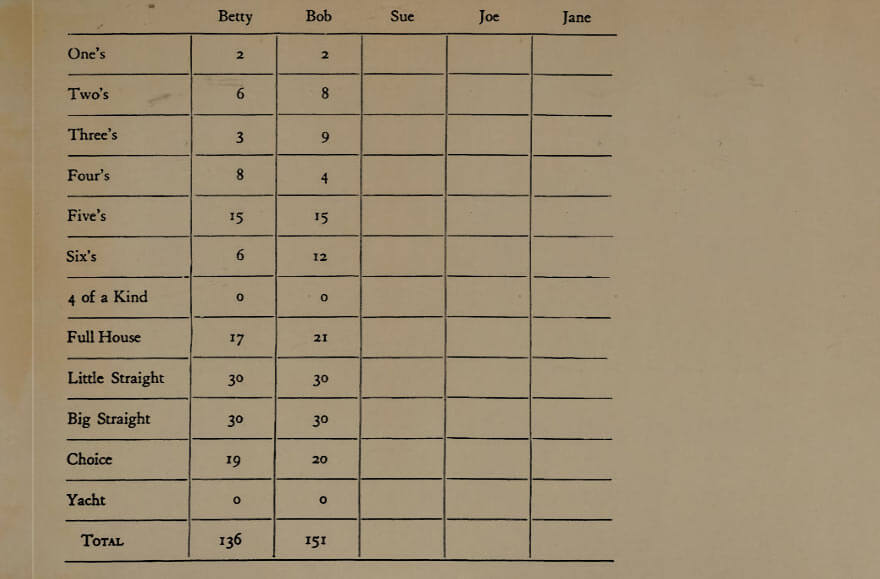
One such game from the early 20th century was called Yacht. It used five dice and a scoresheet to track combinations like full houses, straights, four of a kind and five of a kind. Yacht is widely recognized as the direct ancestor of Yahtzee. The game did not have a known inventor but instead appears to have developed informally among upper-class social circles, especially in yacht clubs and on long sea voyages, which is how it got its nautical name.
The earliest known printed rules for Yacht appeared in the 1935 book Social Games for Recreation, written by Bernard S. Mason and Elmer D. Mitchell and published by A. S. Barnes and Company. In that version, players took turns rolling five dice up to three times per turn, trying to fill out a scoresheet with twelve categories. However, it lacked several features that would later become standard in Yahtzee. There was no Three of a Kind category, no upper-section bonus and no reward for rolling multiple five-of-a-kinds. The scoring category known today as “Chance” was simply called “Choice.” The structure was recognizable, but it was simpler and more limited than the modern version.
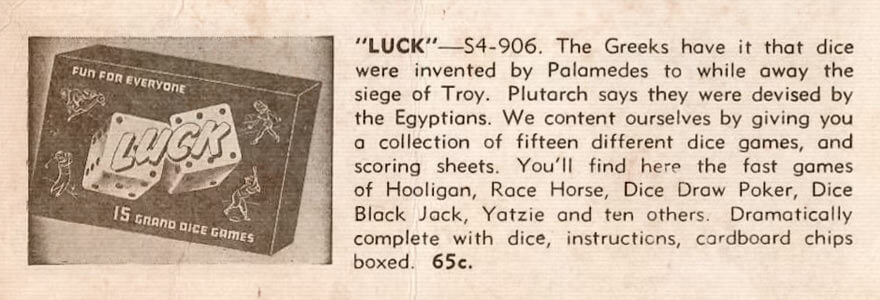
A few years later, during the 1940s, a boxed set called Luck: 15 Grand Dice Games released in 1943 by the Leister Game Company included a game named Yatzie, which also used five dice and featured similar scoring patterns. The set was designed to meet the growing demand for indoor activities during wartime rationing. Though Yatzie was not a direct predecessor, its format suggests that Yahtzee was shaped by more than one early dice game. The similarity in name also hints that the eventual title Yahtzee may have been influenced by games like Yatzie as structured dice scoring was already gaining ground in home entertainment.
The Canadian Couple and the Yacht Game
The version of the game that eventually became Yahtzee can be traced to an unknown Canadian couple in the early 1950s. They regularly hosted friends aboard their private yacht and introduced them to a dice game they called "The Yacht Game." It closely followed the 1935 printed rules for Yacht but may have included small changes in how the scoresheet was arranged or how turns were recorded.
Although their names have never been publicly revealed, the couple is widely credited with popularizing the game among friends, many of whom encouraged them to publish it. Instead of self-publishing, they brought the idea to Edwin S. Lowe, a businessman already known for transforming the game of Beano into the national hit Bingo.
Edwin S. Lowe: The Man Who Made Yahtzee a Household Name
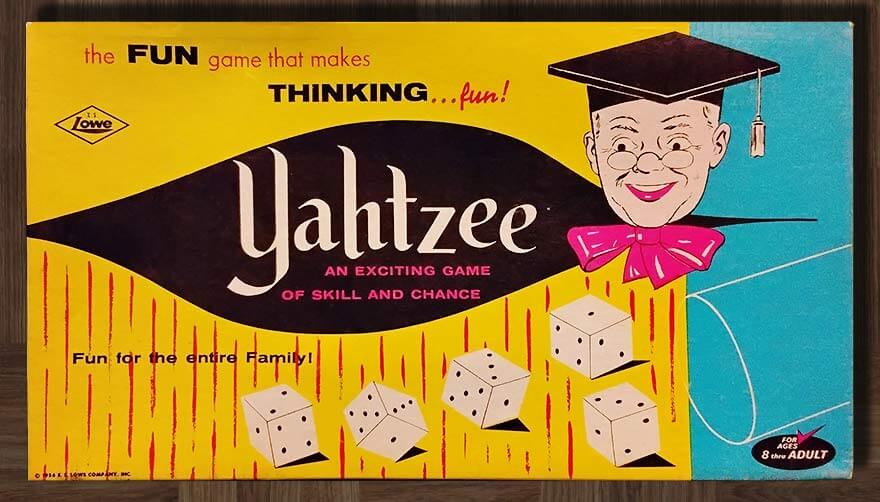
Lowe saw potential in the Yacht Game and agreed to produce the first 1,000 copies so the couple could give them away to friends. In return, he acquired the rights to publish the game himself. Drawing on the name Yacht and perhaps influenced by earlier games like Yatzie, he renamed it Yahtzee and released it in 1956 through his company, the E.S. Lowe Company. For the commercial version, Lowe introduced a more structured scorepad with separate upper and lower sections, added a Three of a Kind category and included new scoring rules such as the 35-point upper-section bonus and extra points for rolling additional Yahtzees. These changes helped turn the game from a casual pastime into a polished boxed product that was ready for store shelves.
Even with its updated format, Yahtzee did not become an instant success. Shoppers were often unsure of what kind of game it was by simply looking at the box. To overcome this, Lowe came up with a creative marketing solution: he organized Yahtzee parties. At these events, guests were invited to play the game together and learn the rules in a relaxed social setting. It was an effective strategy. Word spread quickly and the game began to sell. It wasn’t long before Yahtzee became a staple of American households.
Yahtzee and the Rise of Family Game Night
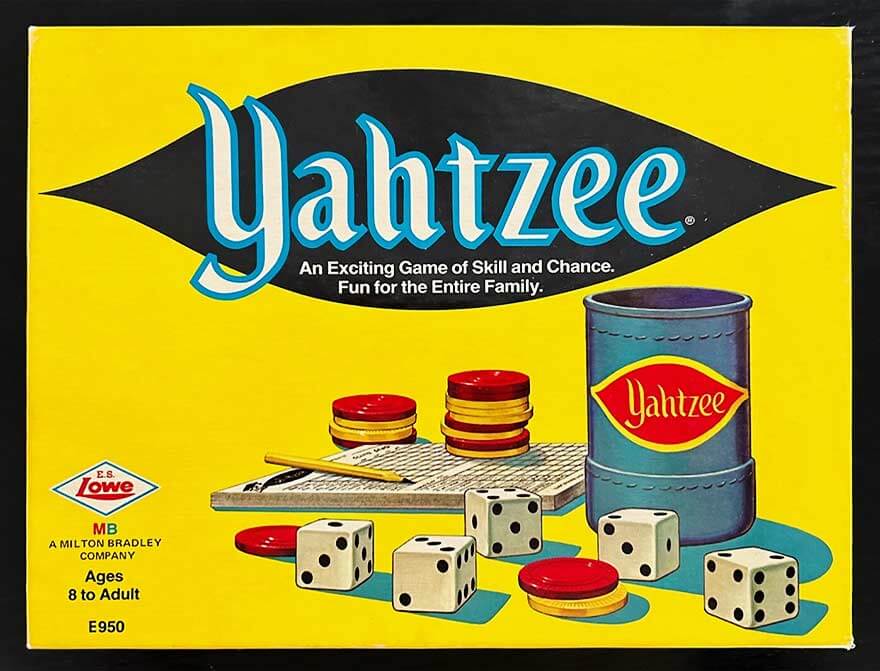
Throughout the 1960s and 1970s, Yahtzee grew in popularity as part of a broader rise in family-oriented board games. Its appeal lay in its simplicity: it was easy to learn, fast-paced and suitable for all ages. Players needed both luck and a bit of strategy which gave it wide appeal.
In 1973, the Milton Bradley Company acquired the E.S. Lowe Company and took over the rights to Yahtzee. Backed by the company’s strong marketing and national distribution, the game reached a much wider audience and entered a new period of success. Over the next several years, versions like Triple Yahtzee, Travel Yahtzee and Word Yahtzee were released, helping to keep the brand fresh and popular.
Hasbro and the Digital Age
In 1984 Hasbro acquired the Milton Bradley Company and with it the rights to Yahtzee. Hasbro, already known for brands like G.I. Joe, My Little Pony and Transformers, was expanding into board games to grow its influence in family entertainment. Adding titles like Yahtzee helped the company reach even more households and strengthen its position in the global toy market.
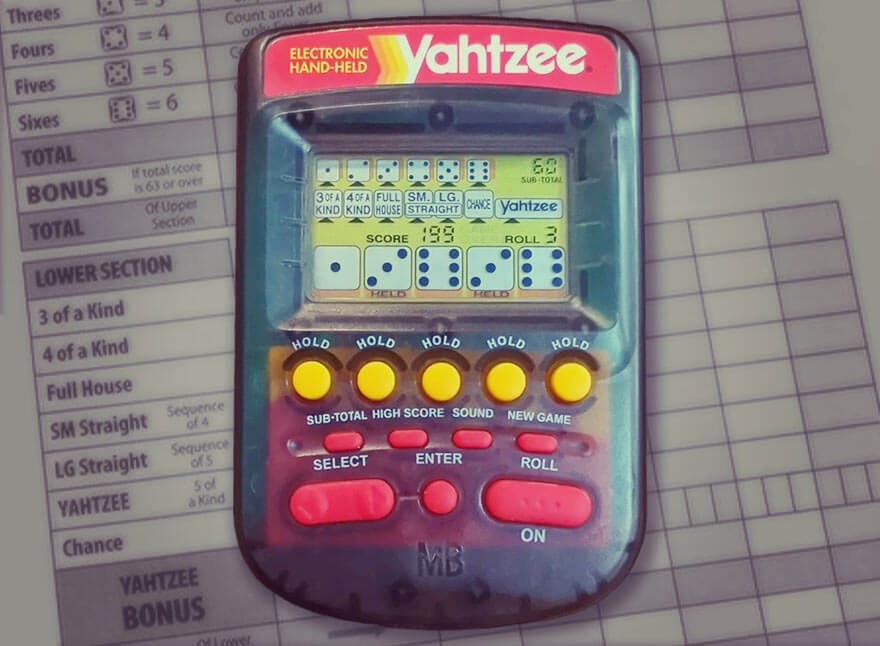
Throughout the 1990s, Hasbro began adapting Yahtzee for the digital age. It was one of the first traditional board games to appear in handheld electronic format, starting with a 1995 LCD version made by Tiger Electronics. These compact, battery-powered devices handled scoring and dice rolls digitally. They were small enough to take anywhere and helped introduce Yahtzee to a younger, more tech-savvy audience.
Desktop versions soon followed, designed for Windows and Mac computers. These editions offered updated graphics, automatic scorekeeping and the option to play against computer opponents. Players could practice strategies without needing a second person or a pad of score sheets. By the late 1990s, Yahtzee was part of larger digital board game collections that bundled it with titles like Monopoly and Scrabble.
The early 2000s brought Yahtzee into the online world. Web-based versions allowed players to compete against each other remotely, compare high scores and enjoy casual gameplay on demand. As internet access became more common in homes and schools, Yahtzee remained relevant by being one of the easiest games to pick up and play, even during a lunch break or study session. In the 2010s, Yahtzee expanded to mobile apps, most notably with Yahtzee With Buddies. Developed by Scopely under Hasbro’s license, the app quickly became a hit, reaching over 1 million downloads within the first four days on Google Play.
Hasbro’s strategy to bring Yahtzee into digital platforms paid off. The game found success across devices and generations, while still maintaining the familiar five-dice gameplay that made it popular in the first place. From physical dice cups to smartphone screens, Yahtzee proved it could keep up with changing technology without losing what made it fun.
